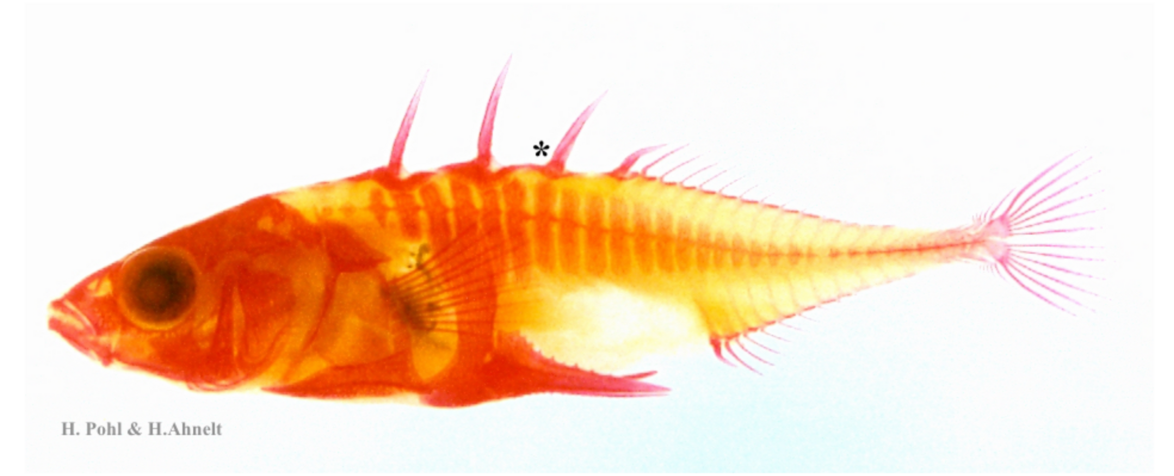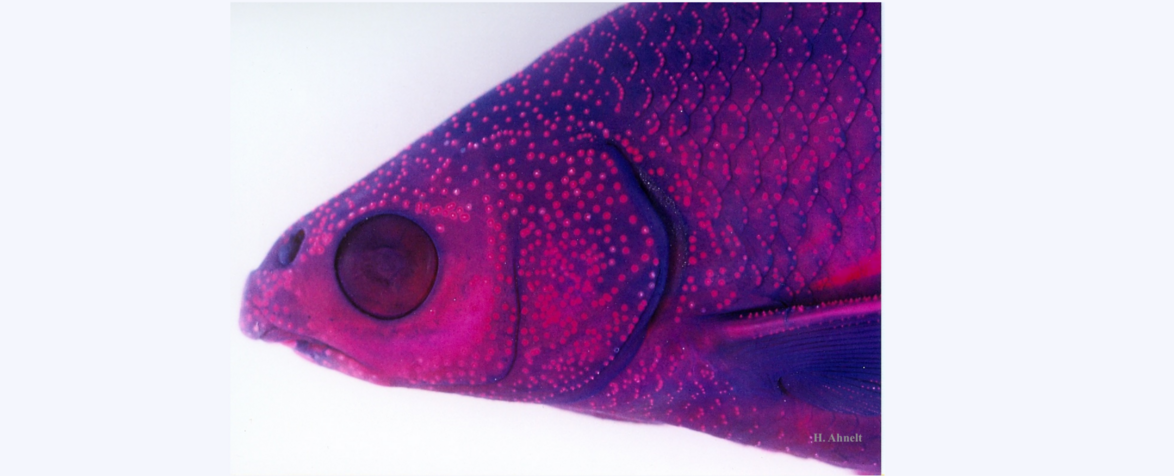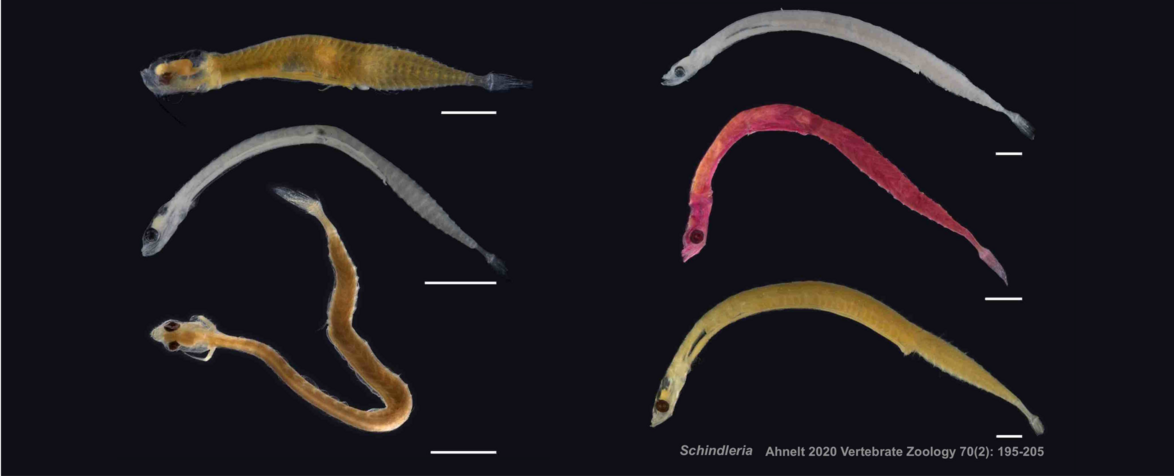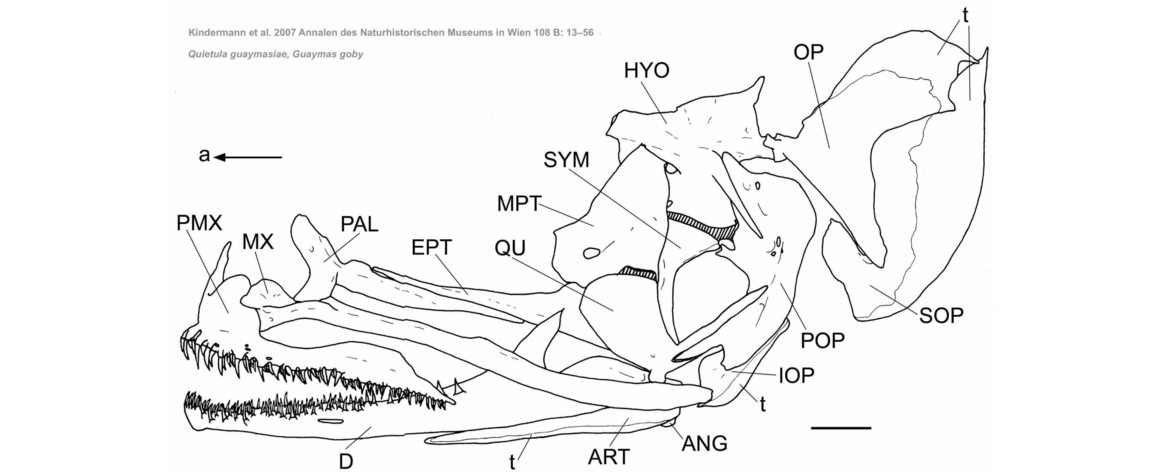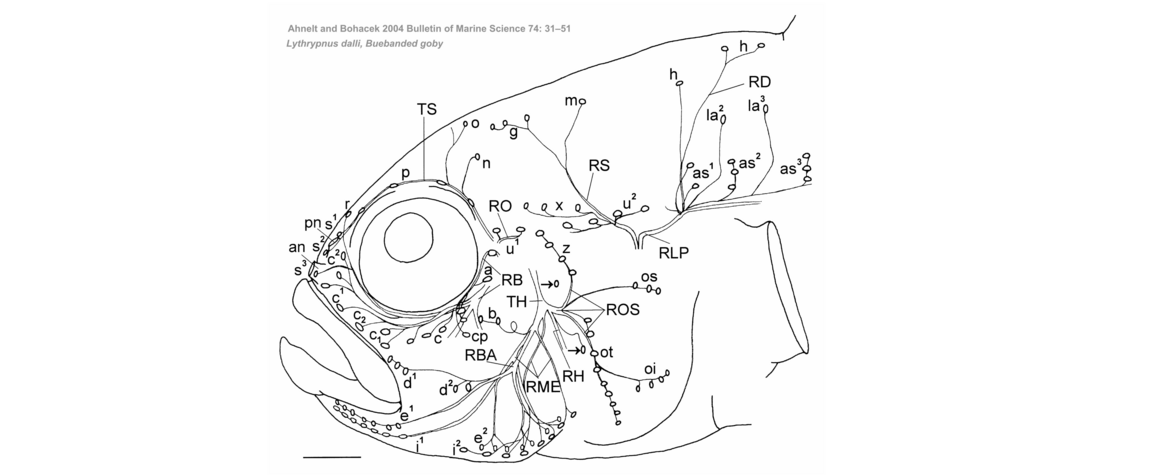Eco-evo-devo
Phenotypic plasticity
How is biological diversity generated? Crucial roles are attributed to mutation, drift and natural selection. Increasingly, also phenotypic plasticity is recognized as an important factor in evolutionary change. Natural selection favors those traits that are beneficial for an organism and adaptations thus generally improve the organismal fit to the environment. When invading a new environment, or living in a changing environment, an organism has to cope with new or changing conditions, in which phenotypic plasticity can be advantageous. In our work we focus on traits closely linked to feeding (oral-pharyngeal-jaw systems), swimming (propulsion system) and orientation (lateral-line system) of fishes. We are interested how these traits respond to environmental shifts developmentally (based on the extremely progenetic Infant fishes, Schindleria), geographically (based on the phenotypically very plastic threespine stickleback, Gasterosteus aculeatus) and temporally (based on the Atlantic herring, Clupea harengus, a species which has to cope with zooplankton communities altered by climate change, its favorite prey).
Population biology of amphibians
In field work on amphibian populations, we follow two aims:
1) to explore questions of evolutionary ecology, such as causes and consequences of variation in life-history traits, or the role of phenotypic plasticity in adaptation;
2) to provide baseline data on natural history for information of conservation projects.
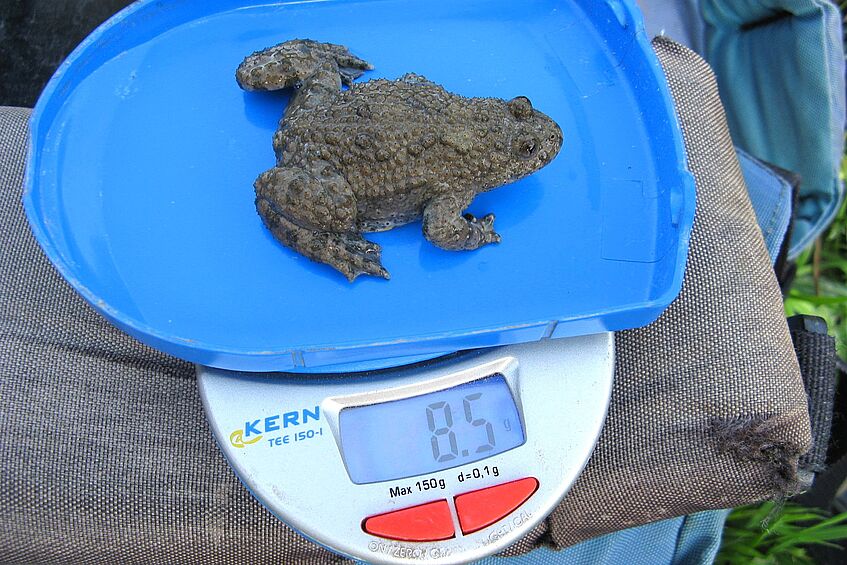
Yellow-bellied toad cooperating in data acquisition.
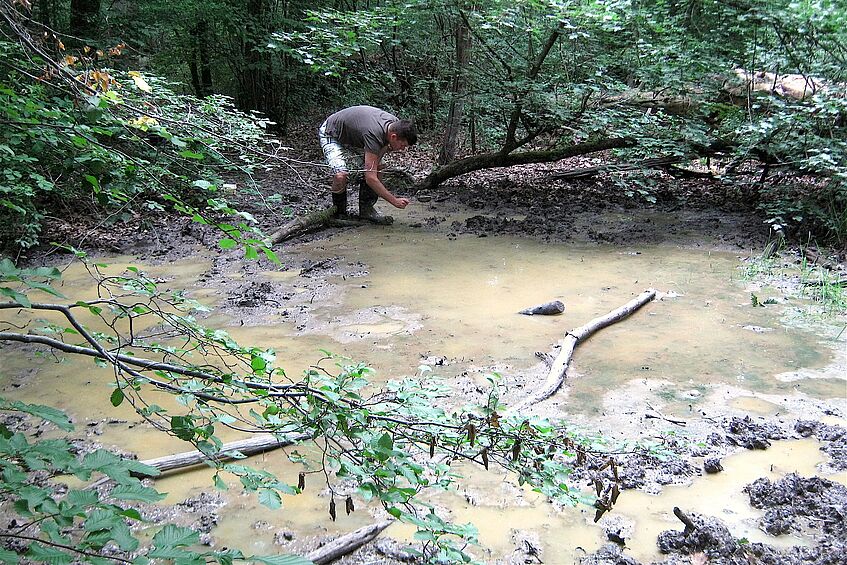
Fire salamanders breed also in such murky pools.
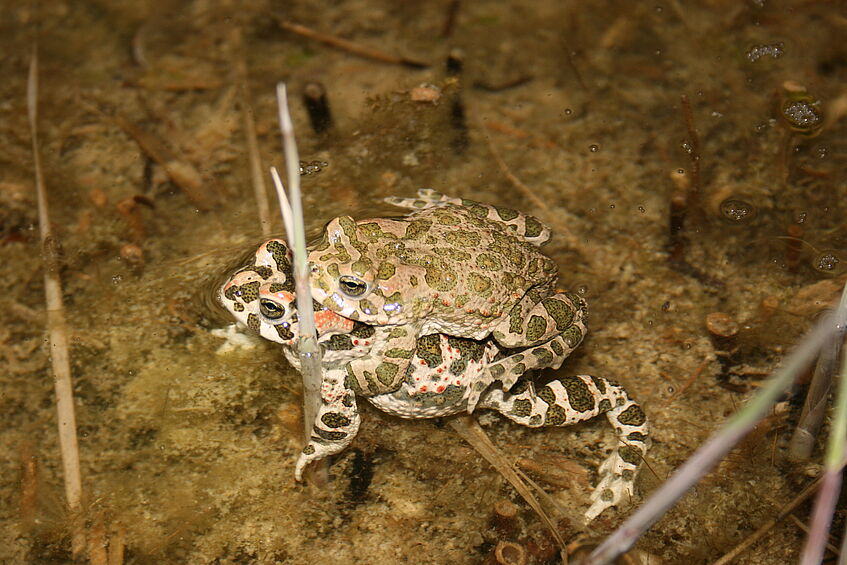
Green toads live in some gardens and parks in Vienna © Eileen Heyer
In a long-term study on yellow bellied toads, Bombina variegata, we have been collecting data on population dynamics and dispersal for 25 years. Over this time-span, climate warming appears to have accelerated individual life-histories.
Fire salamanders, Salamandra salamandra, use a wide range of breeding sites in the Vienna Woods, from clear streams to turbid pools. We investigate to what extent life-histories of salamanders differ in subpopulations of these contrasting habitats.
Green toads, Bufotes viridis, are threatened in Vienna (and elsewhere), but manage to survive in some peculiar habitats. We initiated studies on population dynamics of these urban toads, which are now continued and expanded in cooperation with the group of Lukas Landler (University of Natural Resources and Life Sciences).
Selected publications and theses
Phenotypic plasticity
Ahnelt, H. (2020). A new species of Schindleria (Teleostei: Gobiidae) from Tahiti (French Polynesia) with a unique dentition of the lower jaw. Vertebrate Zoology, 70, 195–205. doi:10.26049/VZ70-2-2020-07
Ahnelt, H., Wibowo, A., Prianto, E. (2020). A new species of Pectenocypris (Teleostei: Cyprinidae) from peat swamps in Sumatra. Vertebrate Zoology, 70, 1–8. doi:10.26049/VZ70-1-2020-01
Ahnelt, H., Sauberer, M. (2018). A new species of Schindler’s fish (Teleostei: Gobiidae: Schindleria) from the Malaya Archipelago (Southeast Asia), with notes on the caudal fin skeleton of Schindleria. Zootaxa, 4531, 95–108. doi:10.11646/zootaxa.4531.1.4
Ahnelt, H., Schade, F. M., Wegner, K. M. (2016). Ocean acidification leads to deformations of caudal vein angio-architecture in juvenile threespine stickleback, Gasterosteus aculeatus Linnaeus. Journal of Fish Diseases, 8, 1001-1005. doi:10.1111/jfd.12417
Ahnelt, H., Herdina, N., Metscher, B. D. (2015). Unusual pharyngeal dentition in the African Chedrin fishes (Teleostei: Cyprinidae): significance for phylogeny and character evolution. Zoologischer Anzeiger – A Journal of Comparative Zoology, 255, 85-102. doi:10.1016/j.jcz.2015.02.007
Ott, A., Löffler, J., Ahnelt, H., Keckeis, H. (2012). Early development of the postcranial skeleton of the pike perch Sander lucioperca (Teleostei: Percidae) relating to developmental stages and growth. Journal of Morphology, 273, 894-908. doi:10.1002/jmor.20029
Kindermann, G., Miljkovic, N., Ahnelt, H., Stevenson, D. E. (2007). The osteology of Eucyclogobius newberryi and Quietula guaymasiae (Teleostei: Gobiidae), two closely related Gobionellines from the east Pacific. Annalen des Naturhistorischen Museums in Wien, 108B, 13-56. www.jstor.org/stable/41767357
Ahnelt, H., Pohl, H., Milkovic, N., Hilgers, H. (2006). Phenotypic diversity in the threespine stickleback Gasterosteus aculeatus Linnaeus 1758 (Teleostei: Gasterosteidae) in western Austria – the four-spine form. Annalen des Naturhistorischen Museums in Wien, 107B, 25-38. https://www.jstor.org/stable/41767334
Ahnelt, H., Bohacek, V. (2004). The lateral line system of two sympatric eastern Pacific gobiid fishes of the genus Lythrypnus (Teleostei: Gobiidae). Bulletin of Marine Science, 74(1), 31-51.
Ahnelt, H., Göschl, J., Dawson, M. N., Jacobs, D. K. (2004). Geographic variation in the lateral line canals of Eucyclogobius newberryi (Teleostei, Gobiidae) and its comparison with molecular phylogeography. Folia Zoologica, 53(4), 385-389.
Population biology of amphibians
Sistani, A., Burgstaller, S., Gollmann, G., Landler, L. (2021). The European green toad, Bufotes viridis, in Donaufeld (Vienna, Austria): status and size of the population. Herpetozoa 34: 259-264. https://herpetozoa.pensoft.net/article/75578/
Schmölz, K., Pinder, A., Kuchling, G., Gollmann, G. (2021). Evaluating candidate wetlands for the assisted colonization of the western swamp turtle Pseudemydura umbrina in a changing climate: macro-invertebrate food resources and turtle diet. Aquatic Conservation: Marine and Freshwater Systems 31: 1847-1858. https://doi.org/10.1002/aqc.3543
Burgstaller, S., Leeb, C., Ringler, M., Gollmann, G. (2021). Demography and spatial activity of fire salamanders, Salamandra salamandra (Linnaeus, 1758), in two contrasting habitats in the Vienna Woods. Herpetozoa 34: 23-34. https://herpetozoa.pensoft.net/article/58496/
Pail, M., Landler, L., Gollmann, G. (2020). Orientation and navigation in Bufo bufo: a quest for repeatability of arena experiments. Herpetozoa 33: 139-147. https://herpetozoa.pensoft.net/article/52854/
Hantzschmann, A.M., Gollmann, B., Gollmann, G., Sinsch, U. (2019). The fast–slow continuum of longevity among yellow-bellied toad populations (Bombina variegata): intrinsic and extrinsic drivers of variation. PeerJ 7: e8233.
Vesely, K. (2019). Detection of the Chytrid-fungus: Biomonitoring using Environmental DNA and its potential planktonic predators in Vienna. http://othes.univie.ac.at/56639/
Baumgartner, M. (2017). Ein Leben zwischen wildem Wasser und steilem Fels. Populationsökologische Untersuchung an der Gelbbauchunke (Bombina variegata) im Nationalpark Gesäuse. http://othes.univie.ac.at/46778/
Mayerhofer, M. (2013). Life-history variation in fire salamanders (Salamandra salamandra, Linnaeus, 1758) in the Vienna Woods. http://othes.univie.ac.at/30801/
Keckeis, S. (2013). Geometric morphometrics of body shape of Salamandra salamandra larvae from diverse water bodies. http://othes.univie.ac.at/29799/
Primus, J. (2013). Dispersal and migration in yellow-bellied toads, Bombina variegata. http://othes.univie.ac.at/28626/
Gollmann, G., Schedl, H., Philippi, D., Reckendorfer, W., Waringer-Löschenkohl, A. (2013). Frogs in the city: problems of research and conservation of amphibians in Lobau (Vienna, Donau-Auen National Park). In: 5th Symposium for Research in Protected Areas, Mittersill, 227-230.

